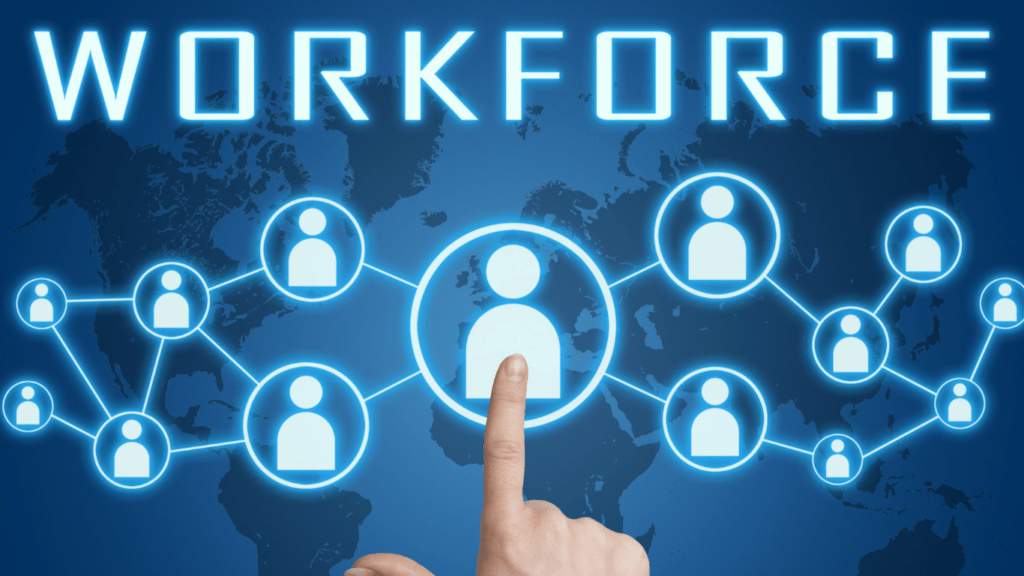Understanding Workforce Trends
Workforce trends are shaping how industries operate and redefining career landscapes. Identifying the drivers behind these shifts helps businesses and workers stay competitive in the evolving economy.
Key Factors Driving Change in the Job Market
Several factors are influencing the job market, creating new opportunities and challenges.
- Remote Work Growth: Hybrid and remote models are becoming widespread, with 58% of Americans able to work remotely, according to McKinsey. This shift is altering workplace dynamics and job expectations.
- Economic Restructuring: Changes like industry declines and emerging sectors are redistributing demand for skills, with green energy and healthcare among the fastest-growing fields.
- Demographic Shifts: Aging workforces in advanced economies and younger populations in developing regions are reshaping labor availability and skill priorities.
- Evolving Consumer Preferences: Growing demand for personalized and tech-driven experiences is influencing hiring in sectors like e-commerce, software, and digital marketing.
The Role of Technology and Automation
Technology and automation are redefining job roles and skills, driving significant transformation across sectors.
- Job Creation and Elimination: While automation replaces routine tasks in manufacturing and retail, it generates roles in software development, AI management, and robotics.
- Emerging Tools: Technologies like AI-powered analytics and IoT are enhancing operational efficiency, increasing demand for data scientists and engineers.
- Reskilling Imperative: Workers proficient in technical, digital, and cognitive skills are leveraging better career opportunities as automation reshapes job requirements.
- Human-Machine Collaboration: Roles requiring teamwork between humans and systems, such as in augmented reality-enabled industries, are becoming common.
Emerging Industries and Job Opportunities

Adapting to shifting economic conditions has spurred growth in several industries. New career pathways are opening as technological advancements and environmental priorities reshape the job market.
Growth in Green Energy and Sustainability
Efforts to combat climate change are driving investments in renewable energy and sustainable practices. Jobs in solar and wind energy, such as solar panel installers and wind turbine technicians, are growing rapidly. The U.S. Bureau of Labor Statistics projects a 44% increase in solar photovoltaic installer roles from 2021 to 2031. Sustainability-focused industries, including green building design and carbon management, also offer opportunities for engineers, project managers, and environmental consultants. Meeting sustainability goals is increasingly essential for businesses, creating demand for professionals who can integrate eco-friendly strategies into operations.
Expansion of Remote Work and Its Impacts
Remote work has escalated in recent years, leading to changes in demand for digital and communication-focused roles. Cybersecurity analysts, data engineers, and IT support specialists are becoming critical for maintaining secure and efficient remote work environments. Additionally, roles in virtual team management and employee engagement have emerged, as companies prioritize maintaining productivity and collaboration across dispersed teams. Freelance and gig work platforms are also expanding, offering flexible career options in industries like marketing, software development, and graphic design. Remote work’s continued prevalence is shaping both job creation and professional flexibility.
Skills Needed for the Future Workforce
As the economy evolves, specific skills are gaining importance to meet the demands of a technology-driven and adaptive job market. Workers must prioritize emerging skillsets to stay competitive in this dynamic landscape.
The Rise of Soft Skills and Emotional Intelligence
Soft skills like communication, adaptability, and problem-solving are becoming increasingly significant. For example, as businesses adopt hybrid work models, collaboration tools are essential, but so is the ability to navigate complex team dynamics. Emotional intelligence, including empathy and self-awareness, helps build stronger workplace relationships and enhances leadership capabilities. According to LinkedIn’s 2023 Workplace Learning Report, skills like emotional intelligence and adaptability feature prominently among the top skills employers seek as automation grows.
Importance of Lifelong Learning and Upskilling
Continuous skill development is critical for workers navigating disrupted industries. Reskilling in digital technologies, such as data analysis or AI integration, positions individuals for roles in high-demand sectors. For instance, online platforms like Coursera and LinkedIn Learning have seen a 30% increase in users acquiring tech-related certifications over the past three years. Lifelong learning ensures workers can adapt to shifting trends, with upskilling in technical and green economy skills offering access to emerging opportunities in sustainable energy, virtual services, and AI management.
Challenges in Adapting to Workforce Trends
Adapting to shifting workforce trends involves navigating several challenges tied to:
- economic shifts
- technology
- societal changes
These obstacles require strategic efforts to ensure resilience and equitable opportunities.
The Impact of Economic Uncertainty
Economic fluctuations complicate workforce planning by creating instability in job markets. Recession risks and inflation force businesses to reassess hiring strategies, often leading to slowed recruitment or layoffs. For example, significant reductions in sectors like tech have left skilled workers displaced. Companies often prioritize cost-saving measures over innovation during downturns, hindering workforce investments.
Workers face personal financial strain when economic volatility limits job availability or suppresses wages. Inconsistent demand for certain roles also creates uncertainty in career longevity. Professionals in industries prone to rapid restructuring, such as manufacturing and retail, experience heightened vulnerability.
Addressing Inequality and Job Displacement
Technological advancements magnify inequality when upskilling opportunities are unevenly distributed. Many low-income workers lack access to training programs, leaving them ill-prepared for high-demand tech-oriented roles. For instance, roles requiring cloud computing or data analytics skills may exclude those unable to afford certifications.
Automation-driven job displacement disproportionately impacts routine-intensive positions. Workers in administrative or assembly-line roles face job losses, with limited pathways to transition into emerging fields. Additionally, freelance and gig-economy models exacerbate wage disparities, as independent contractors often lack benefits and stable income compared to full-time employees.
Creating comprehensive reskilling initiatives, particularly for underserved populations, could mitigate these effects. Employers integrating diversity-focused programs and governments investing in community-based workforce programs might effectively reduce disparities in job accessibility and stability.





